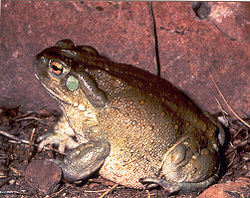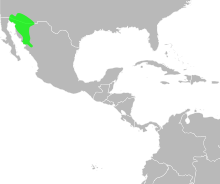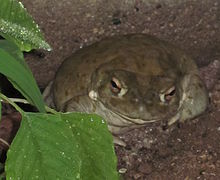- Colorado River toad
-
Colorado River toad 
Conservation status Scientific classification Kingdom: Animalia Phylum: Chordata Class: Amphibia Order: Anura Family: Bufonidae Genus: Bufo Species: B. alvarius Binomial name Bufo alvarius
Girard in' Baird, 1859
Synonyms Ollotis alvaria
(Frost, 2006)The Colorado River toad, Bufo alvarius, also known as the Sonoran Desert toad, is a psychoactive toad found in northern Mexico and the southwestern United States. Its skin and venom contain 5-MeO-DMT and bufotenin.
Contents
Description
The Colorado River toad is carnivorous, eating small rodents, insects, and small reptiles and other toad species; like many toads, it has a long, sticky tongue which aids it in catching prey. It lives in both desert and semi-arid areas throughout the range of its habitat. It is semi-aquatic and are often found in streams, near springs, and in canals and drainage ditches. It often makes its home in rodent burrows, and is nocturnal. It has a loud, piercing call.
The toads generally breed in small rain pools after the summer showers start; they spend approximately one month as yellowish-brown tadpoles before moving onto the land. They grow to be up to 4–7 inches long.
Venom and U.S. law
The toad's primary defense system are glands that produce a poison that may be potent enough to kill a grown dog.[1][dubious ] These parotoid glands also produce the 5-MeO-DMT [2] and bufotenin for which the toad is known; both of these chemicals belong to the family of hallucinogenic tryptamines. These substances, present in the skin and venom of the toad, produce psychoactive effects when smoked.
The toads received national attention after a story was published in the New York Times Magazine in 1994 about a California teacher who became the first person to be arrested for possessing the venom of the toads.[3][4] The substance concerned, bufotenin, had been outlawed in California in 1970.[5]
In November 2007, a man in Kansas City was discovered with a B. alvarius toad in his possession, and charged with possession of a controlled substance after they determined he intended to use its secretions to get high.[6][7] In Arizona one may legally bag up to ten toads with a fishing license but it could constitute a criminal violation if it can be shown that one is in possession of this toad with the intent to milk and smoke its venom.[8]
It should also be noted that none of the states in which B. alvarius is (or was) indigenous - California, Arizona, and New Mexico - legally allow a person to remove the toad from the state. For example, the Arizona Department of Game and Fish is clear about the law in Arizona: "An individual shall not... export any live wildlife from the state; 3. Transport, possess, offer for sale, sell, sell as live bait, trade, give away, purchase, rent, lease, display, exhibit, propagate... within the state..."[8]
In California, B. alvarius has been designated as "endangered" and possession of this toad is illegal. "It is unlawful to capture, collect, intentionally kill or injure, possess, purchase, propagate, sell, transport, import or export any native reptile or amphibian, or part thereof..."[9]
In New Mexico, this toad is listed as "threatened" and, again, taking B. alvarius is unlawful.[10][11]
References
- ^ Steven J. Phillips, Patricia Wentworth Comus (eds.) (2000). A Natural History of the Sonoran Desert. University of California Press. p. 537. ISBN 0-520-21980-5.
- ^ Toxins of Bufo alvarius
- ^ "Missionary for Toad Venom Is Facing Charges". New York Times. 20 February 1994. http://www.nytimes.com/1994/02/20/us/missionary-for-toad-venom-is-facing-charges.html.
- ^ "Couple Avoid Jail In Toad Extract Case". New York Times. 1 May 1994. http://www.nytimes.com/1994/05/01/us/couple-avoid-jail-in-toad-extract-case.html.
- ^ Kate Bernheimer (2007). Brothers & beasts: an anthology of men on fairy tales. Wayne State University Press. pp. 157–159. ISBN 0814332676. http://books.google.com/books?id=AMagcGzh8CkC&pg=PA157.
- ^ "'Toad Smoking' Uses Venom From Angry Amphibian to Get High". FOX News (Kansas City). 3 December 2007. http://www.foxnews.com/story/0,2933,314619,00.html.
- ^ Natalie Shelton (7 November 2007). "Drug sweep yields weed, coke, toad". KC Community News. Archived from the original on 1 June 2011. http://web.archive.org/web/20071214110048/http://www.kccommunitynews.com/articles/2007/11/07/smithville_herald/news/g.sh.news.bad.candy.txt.
- ^ a b AZGFD.gov
- ^ "Title 14. Division 1. Subdivision 1. Chapter 5., § 40(a)". http://government.westlaw.com/linkedslice/default.asp?SP=CCR-1000.
- ^ 19.33.6 NMAC
- ^ 19.35.10 NMAC
- Pauly, G. B., D. M. Hillis, and D. C. Cannatella. (2004) The history of a Nearctic colonization: Molecular phylogenetics and biogeography of the Nearctic toads (Bufo). Evolution 58: 2517–2535.
- Hammerson & Santos-Barrera (2004). Bufo alvarius. 2006. IUCN Red List of Threatened Species. IUCN 2006. www.iucnredlist.org. Retrieved on 12 May 2006. Database entry includes a range map and justification for why this particular species is of least concern
- Frost, Darrel R., et al.; Grant, Taran; Faivovich, JuliÁN; Bain, Raoul H.; Haas, Alexander; Haddad, CÉLIO F.B.; De SÁ, Rafael O.; Channing, Alan et al. (2006). "The Amphibian Tree of Life". Bulletin of the American Museum of Natural History 297: 1–370. doi:10.1206/0003-0090(2006)297[0001:TATOL]2.0.CO;2.
External links
- AmphibiaWeb: Biology and Conservation Information
- NatureServe: Conservation Data
- CaliforniaHerps.com: Documenting California's indigenous reptiles and amphibians
- Arizona-Sonora Desert Museum
- Sonoran Desert Toad - Natural History site
- Toad-smoking gains on toad-licking among drug users- Wall Street Journal
- Secretions From Colorado Toad Contain Powerful Psychedelic Compound- NSDN
- Erowid Psychoactive Toad Vault
Media
Categories:- IUCN Red List least concern species
- Psychedelic tryptamine carriers
- Toads
- Fauna of the Lower Colorado River Valley
Wikimedia Foundation. 2010.



